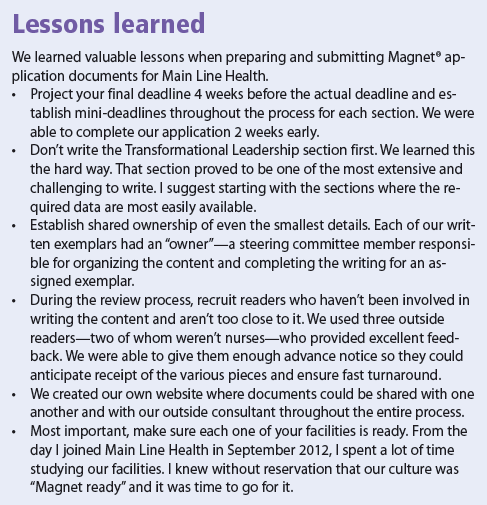In March 2015, Main Line Health® designation became one of only 19 health systems across the nation to receive Magnet® designation for all of its facilities from the American Nurses Credentialing Center (ANCC). My colleagues and I are enormously proud of this achievement—and of every step we travelled together along the way to get here.
Anyone who has been involved in shaping a Magnet submission document—whether for an individual facility or an entire system—understands the arduous process involved. At Main Line Health, our writing journey began in August 2013 immediately after release of the new Magnet application guidelines.
Main Line Health is a not-for-profit health system serving portions of Philadelphia and its western suburbs. We have 10,000 employees, of whom 2,800 are nurses. More than 50% of our nurses are specialty certified and 62% have bachelor’s degrees. The average length of nurse employment is 13.5 years, representing a 93% retention rate.
Previously, three of our hospitals—Lankenau Medical Center, Bryn Mawr Hospital, and Paoli Hospital—achieved Magnet designation—with 2015 marking the third consecutive designation
for these facilities. Also among our facilities with Magnet designation are Riddle Hospital, Main Line Health HomeCare & Hospice division, and Bryn Mawr Rehabilitation Hospital. The latter is one of only four acute rehabilitation centers in the country, and the only one on the East Coast, to achieve Magnet recognition.
Preparation a top priority
We knew that to apply for Magnet designation, we had to be absolutely ready. The first step was to form a strong steering committee for the process. The group included 17 members, including myself, our Magnet director Rosi Wurster, vice presidents of nursing from Main Line Health’s four acute-care hospitals and rehabilitation hospital, nurse directors, nurse managers, nurse educators, and clinical nurses. Each member would play a vital role in building our application, including responsibility for writing designated portions of our 375-page submission document.
Creating a structure and timeline
The first order of business was to formulate a structure for the document and create a detailed timeline for each piece of this enormous project. With an ANCC submission deadline of April 1, 2014, we opted to plan for completion by March 15. This gave us a cushion for anything unexpected and plenty of time for the final review process. We then worked backwards to build a calendar indicating due dates for the various writing assignments, allowing ample time for review and revision at each step. (See Lessons learned.)
While each of our 17 committee members was involved in writing the submission document, we hired an outside consultant to serve as the overall editor—a communications expert who could refine each piece and meld the components together. No one on the committee was a professional writer, so the consultant conducted a writing workshop for us, sharing basic tips and formatting guidelines. This workshop was well-received and proved to be highly beneficial.
We staggered the initial due dates for each of the five sections—Organizational Overview, Transformational Leadership, Structural Empowerment, Exemplary Professional Practice, and New Knowledge, Innovations and Improvements—with copy to be placed on our shared drive beginning as early as November 15. We built in multiple steps to accommodate various reviewers, allowing ample time between each edit stage.
Perhaps the most significant challenge in developing the submission document was creating the formal structure surrounding information gathering and cascading. But our greatest challenge overall was ensuring we had enough data and empirical outcomes to represent equally each of the six entities comprising Main Line Health, in support of each one of the 72 Magnet standards.
Cheers and tears
With our document complete, we submitted our application electronically for the first time (which involved its own learning curve). After ANCC notified us to prepare for their phone call telling us if we’d achieved Magnet designation, we gathered 700 of our colleagues to listen in. The group included nurses and many colleagues across other disciplines. Gaining Magnet designation for all of our facilities is so much bigger than what we do as nurses. Magnet designation recognizes the work of every member of our staff every day. Ultimately, we are all in this together and succeed only because of the people who contribute to the quality of care we deliver.
When the announcement was made, cheers in the room brought tears to my eyes. To celebrate our achievement, Main Line Health held special events at each campus and distributed a $250 bonus to employees across the system, totaling more than $3.2 million. I feel fortunate to work for an organization that values Magnet recognition so highly and recognizes the contributions of its entire team.
But we don’t do what we do simply to achieve Magnet recognition. We do the work of nursing for our patients and our community; we create this environment for each other and for our colleagues across all disciplines because it’s the right thing to do. It’s the core of our work as nurses and reflects our commitment to our patients.
Barbara Wadsworth is senior vice president and chief nursing officer at Main Line Health in southeastern Pennsylvania.



















